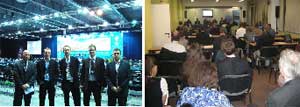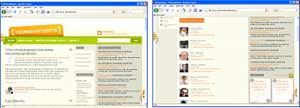PIME Award for Communications
Excellence
The PIME Award highlights
how results-oriented communications can provide added
value to your business. Share the secret of your success
with your fellow communicators and get the peer group
recognition that you deserve!
The 2010 PIME Award for
Communications Excellence aims to recognise the achievements
of professional communicators in the nuclear industry
who have successfully connected with their audiences,
helped to dispel myths and misinformation about nuclear
energy and enhanced the image of our industry.
We
are looking for campaigns that show the most creative
strategy, illustrative
and innovative use of communications tools and can show
tangible results. Multi-media packages backed up by
sophisticated audiovisuals and glossy brochures can
provide impressive results, but so too can a campaign
that ran on limited resources. It’s all about
grass roots, creative communications that really reach
out to their audience.
How the winner is chosen
A jury presided over by Robert Leclère, CEO of Synatom and President of the Belgian Nuclear Forum, will select a shortlist of five campaigns from all those sent in. The selection criteria for selecting the five campaigns are:
-
innovativeness and creativity
-
simplicity of structure
-
clarity of message(s)
-
accessibility of language
-
level of emotion expressed
-
range of tools used
-
measurability of results
-
overall cost/benefits ratio
The five best candidates
will present
their communication campaign during the conference.
The PIME participants will then elect their favourite
one. The PIME 2010 Award winner will be announced during
the closing session.
Presentations from the
Pime Award Candidates:

ATOMEXPO JSC
The Atomexpo JSC campaign spotlights the information centres that Rosatom has set up – and is continuing to expand across Russia. The centres give visitors simple, clear and practical information about nuclear energy and help raise their awareness of its uses and advantages. The campaign’s strategy revolves around an “edutainment” package - combining didactic messages and entertaining audiovisuals - called The World of Nuclear. It combines the latest in cinematographic, 3D and computer-assisted technologies to provide an interactive, high-tech, virtual experience that visitors can understand and relate to.
Open Days, publications, videos, a brochure for children, quizzes and games are part of a range of communications tools and methods used at the centres.

 Nuclear Energy Information Center Nuclear Energy Information Center |

EDF
EDF is carrying out a complete overhaul of its 19 Visitor Centres in France.
This ambitious campaign, which started in 2008 and should finish in 2011, revolves around a “renewal” of the existing Visitor Centres in order to provide even more effective communications.
The strategy is to incorporate a simple and standardized design, quality interactive educational materials (especially for young visitors) and high-tech technology that ensure a hands-on experience. The aim is to use communications techniques that make the whole visit experience unforgettable. Purity and simplicity of design also help to convey a stronger and more unified corporate image for EDF. A full range of communications tools and techniques are exploited, including simulation exercises, practical experiments, multimedia applications and 3D-DVDs.

 EDF Centres for Visitors - Renewal Campaign EDF Centres for Visitors - Renewal Campaign
|

European Nuclear Society
Young Generation Nuclear
ENS Young Generation Nuclear (ENS YGN) was out in force at both the United Nations COP 14 talks in Poznan and the COP 15 talks in Copenhagen. The goal of the ENS YGN side events was to demonstrate to a target audience of mainly anti-nuclear environmental activists that the often expressed stereotypical views about nuclear energy and climate change are inaccurate. It is difficult to gain visibility and to communicate key messages in an overtly political context and in an extremely competitive environment. Within such constraints the event gained the valuable oxygen of publicity thanks to a series of presentations backed up by leaflets, a carton, posters, press articles and personal commitment and testimony.

 COP Climate Conference Activities COP Climate Conference Activities
|

Finnish Energy Industries
The Finish Energy Industries’ campaign blog (there is also a dedicated website, Twitter and other components) targets a very specific group – young people.
A modern, innovative concept backed up by simple, clear messages succeeds in promoting an all-inclusive dialogue. Its softer pro-nuclear approach encouraged true diversity of opinion. Regular postings from experts and people from all backgrounds - even from anti-nuclear groups like Greenpeace – have kept the blog fresh and dynamic. Results were easily measurable and results have been sustained and impressive. This campaign combines the blog with the use of a range of social media communications techniques, such as Twitter and YouTube. Go to www.ydinreaktioita.fi for further information.

 Ydinreaktioita − Core Reactions Ydinreaktioita − Core Reactions
|

ITER
ITER, a multinational partnership for research into harnessing nuclear fusion, was founded in 2007 and is located in Cadarache, southern France. This campaign’s ambitious aim is to create global awareness of and curiosity and enthusiasm for the potential of fusion and to create a global “ITER community” among employees, the local community and beyond.
The communications approach is on three levels:
-
Internally: for employees working on the project to keep them up to date with developments and optimise their working environment
-
Local community: neighbourhood communications and information sessions to provide easy-to-understand information and to emphasise IER4s contribution to the local and regional economy
-
Worldwide: a comprehensive ITER website and a web-based newsletter for the global fusion community that speak clearly about what is a complex subject
An array of tools is used, including worldwide print and electronic media components, social media networking via Facebook and YouTube, posters, a “Do-it-yourself fusion kit,” etc. And the campaign shows the value of adapting tools and messages to the specific needs of different target groups.

|
|

